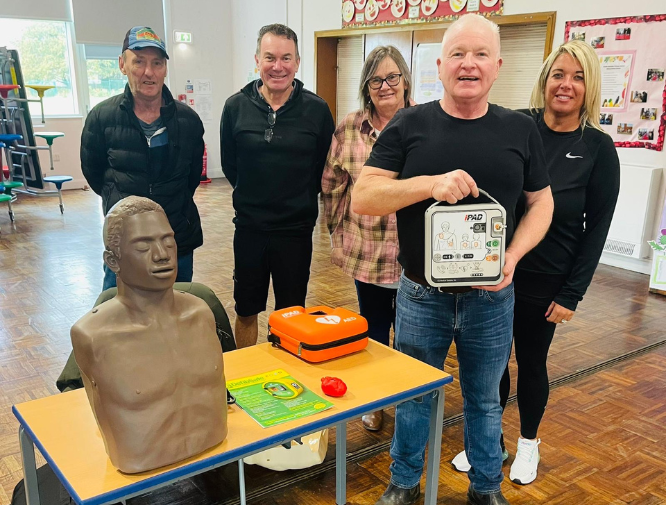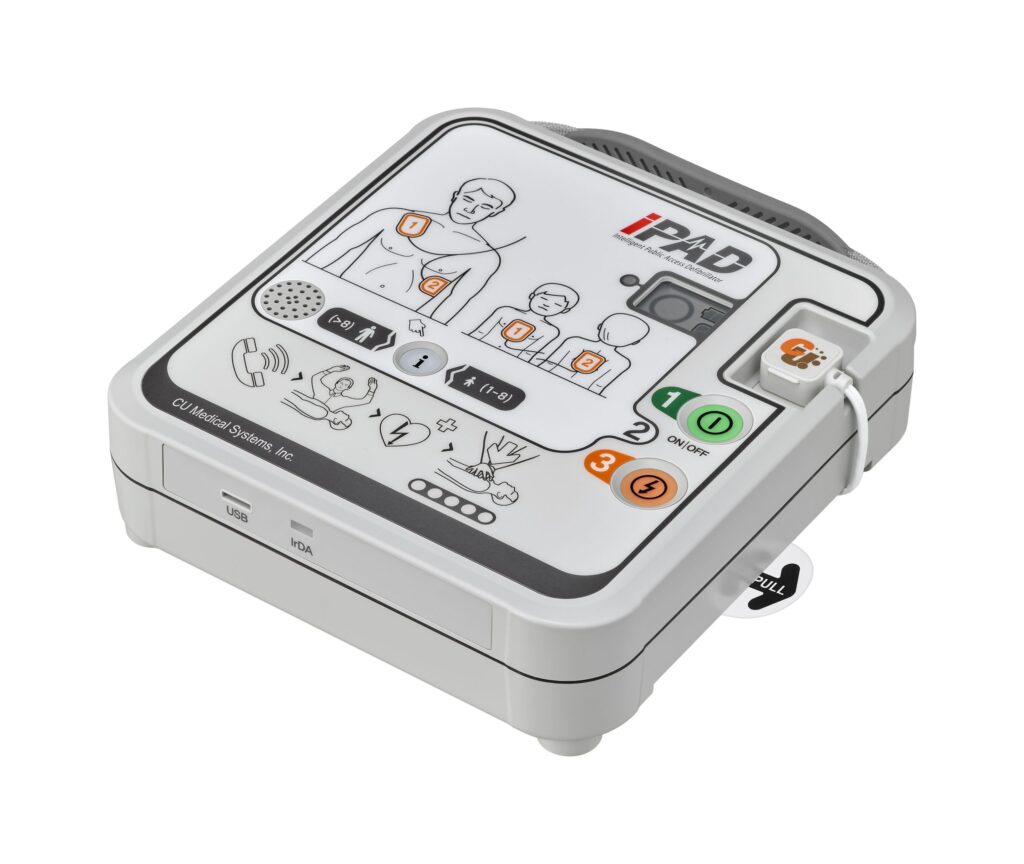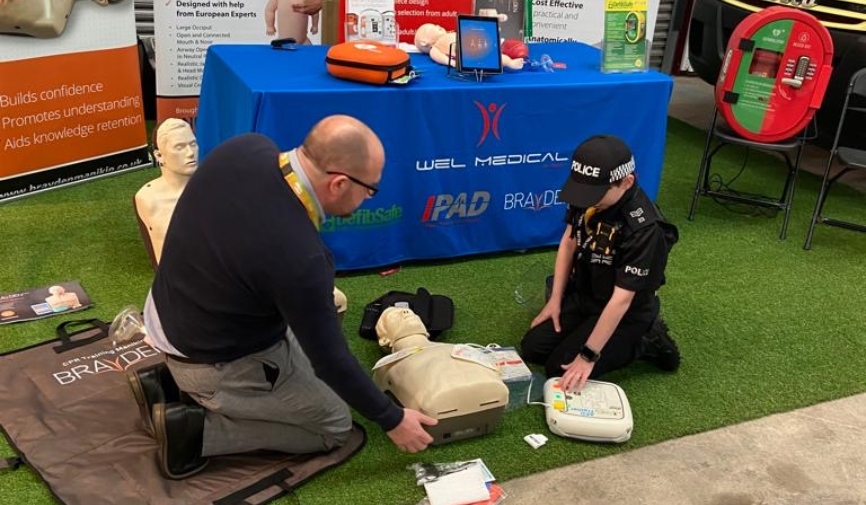In emergencies, having a reliable defibrillator can mean the difference between life and death. Automated External Defibrillators (AEDs) are vital tools in community spaces, workplaces, schools, and more, ensuring immediate response to cardiac emergencies.
But with so many options available, how do you know which AED is right for you? Here, we’ll break down what to look for in an AED, highlighting features that guarantee convenient, effective and safe use. We’ll also shed some light on what sets our own iPAD AEDs apart and discuss how they can help you save more lives.
Header Image: A WEL Medical product familiarisation session for Castle Kennedy Community Council.
Ensure Your AED is Appropriate for All Users
It’s a common myth that cardiac arrests only affect adults. In fact, studies show that 270 children die in school each year as a result of sudden cardiac arrest. This means that making sure that your AED is effective in treating people of all ages is a crucial tip for choosing an AED. There are two key features to keep an eye out for.
Dual Adult/Child Electrode Pads
Dual-purpose pads are designed to adjust the shock levels based on whether they’re used on an adult or a child. The simplicity of having one set of pads for all users saves precious time during an emergency. It removes the necessity to switch pads during an emergency, meaning that no time is wasted fumbling with finding the right pads.
Simple Mode Switching
This is another of the top things to look for in an AED. Switching quickly between adult and child modes must be straightforward. Unlike some other brands of defibrillators, our NFK200 and SP1 AEDs make this process easy with a simple button mechanism, which reduces the complexity during an emergency. Like the dual-purpose pads we use, this saves you vital seconds and reduces confusion and panic.
Above: The iPAD SPR with ‘i’ button to switch between adult and child defibrillation.
Prioritise Comprehensive Guidance
For most bystanders, carrying out defibrillation with an AED will be an entirely new experience. This means that having clear, easy-to-understand guidance can be a massive help. Choose models that provide clear voice prompts and large, clear illustrations that can guide you through every step of the process. Not only do the voice prompts on our defibrillators improve confidence in and competence of your defibrillation, but they also explain how and when to perform CPR.
This shows a holistic approach to Basic Life Support.
We’ve spoken previously about the need to use defibrillation and CPR in tandem, and this is something that our AEDs lend themselves to. Users benefit from an innovative and unique built-in metronome that supports them in delivering the correct compression rate. Studies show that maintaining the right rate of compression can have a profound impact on survival rates.
Above: Training taking place with an iPAD AED at a Pre-Hosptial Trauma Live Show.
Keeping Your AED Charged and Operational is Key
Quickly understanding the operational status of your defib is a must-have in an AED. Arriving at an emergency situation with an ineffectual defibrillator could have life-threatening results. Conducting regular checks on your AED is, of course, a great step, and we’re committed to making this process as straightforward as possible.
Each of our AEDs is equipped with a visual LED status indicator that shows the status of both the defibrillator unit itself and its attached consumables. This means that you have absolute peace of mind knowing that your AED is functional at a glance.
Make sure it’s durable and reliable.
The elements can take a toll on your AED, so making sure that you choose one that is robust enough to withstand. Our new iPAD SPR AED features the highest possible IP rating on a defibrillator – IP66 – earning its ruggedness in water and hazardous surroundings, making it a perfect companion for even the most demanding of situations.
If it does go wrong, you need to be confident it’ll be fixed.
Many defibrillator providers offer a warranty to ensure that, in the unlikely event that your AED malfunctions, you can get it replaced quickly. We offer multi-year warranties that can be extended even further once you register your defibrillator on the Circuit. For groups with limited budgets, choosing an AED that offers a long warranty ensures that they don’t need to worry about replacement costs for many years.
Make Sure Everything is Close to Hand
Having every component of your AED easily accessible is something that’s important to look out for when you’re choosing a defibrillator. In an emergency, the time spent searching for pads, instructions, or other items is time that you can’t afford to spare.
Opting for an AED that has its pads stored in clear compartments on the front of the unit means that everything you need is easily visible and allows you to quickly check the expiration dates and readiness of the pads at a glance. This eliminates display and improves ease of use.
An AED Should Help You Improve Your Processes
Recording and transferring data post-event is crucial for both the analysis and improvement of emergency responses. The ability to review and analyse data from an event can lead to improved training and protocols, ultimately enhancing the quality of care provided. This makes it one of the top things to look for when choosing an AED.
Unlike other brands, our iPAD defibrillators feature internal memory with USB data transfer capabilities. This means that accessing and reviewing event data is easy and straightforward, making your community safer.
Ready to Choose the Right AED?
We’re proud of our track record in strengthening the chain of survival. One of the key ways we achieve this is by providing comprehensive yet easy-to-use defibrillators to the public. Our iPAD AEDs stand apart from others by being incredibly feature-rich without giving way to needless overcomplications. You can find out more about our full range by visiting our shop, or get in touch with us today to find out more.








